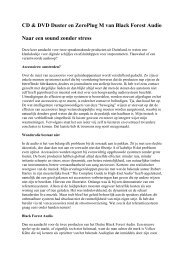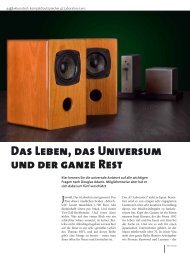Audio Note Japan Kondo Overture - Black Forest Audio
Audio Note Japan Kondo Overture - Black Forest Audio
Audio Note Japan Kondo Overture - Black Forest Audio
You also want an ePaper? Increase the reach of your titles
YUMPU automatically turns print PDFs into web optimized ePapers that Google loves.
<strong>Audio</strong> <strong>Note</strong> <strong>Japan</strong> <strong>Kondo</strong> <strong>Overture</strong><br />
Aug 10, 2012<br />
Kari Nevalainen<br />
Have you noticed how <strong>Japan</strong>ese audiophiles (some of them) have the habit of<br />
closing their eyes and waving their hand with the music as if they were conducting<br />
the orchestra. I don't know exactly what that is about but I guess that's their way of<br />
internalizing music. The reason I'm telling this is that hand waiving was the first thing<br />
that popped into my mind while listening to <strong>Audio</strong> <strong>Note</strong> <strong>Japan</strong>'s <strong>Kondo</strong> <strong>Overture</strong><br />
integrated amplifier. It was that natural. More of that later.<br />
Despite its 25000 euro price, the <strong>Overture</strong> is the cheapest what ANJ can offer for its<br />
fans. <strong>Overture</strong> ain't Ongaku. The chassis is made of aluminium instead of copper,<br />
and the <strong>Overture</strong>'s OPTs are pure copper, not silver as in the Ongaku. The ANJ's<br />
own silver is treated with age annealing. Is their copper as well?<br />
Here's what ANJ's Masaki Ashizawa told me:<br />
"First of all, silver is a relatively soft material, which will "self anneal" with time, and<br />
too much additional annealing makes it "over" soft. This generates a lot of problems<br />
for the cable manufacturing process resulting in a lower audio performance. Simply<br />
put, using "age annealing" means to find the best balance point when applied to<br />
silver cables. Copper, on the other hand, delivers its best audio performance in its<br />
high purity form. Applying annealing will oxidize it easily, which eventually lowers its
purity. Therefore we did not apply any annealing to the copper used at the <strong>Overture</strong><br />
transformers. But don't worry, winding skills is another very important factor in<br />
making transformers, and all transformers in <strong>Overture</strong> are skillfully hand-made by<br />
ANJ. This is at least as significant a feature than the wire material."<br />
<strong>Overture</strong> ain't a Class A single-ended amplifier with a fancy triode tube as its bigger<br />
sister. Instead it's a common Class AB push-pull design with common EL-34<br />
pentodes. What's the secret then?<br />
Masaki Ashizawa: "That's what's audiophiles keep constantly asking. At CES 2011,<br />
visitors praised the sound of the <strong>Overture</strong> as silky smooth, elegant yet with very clean<br />
and good dynamics. They thought that the circuit must be either Triode or Single-<br />
Ended design. Once we told them that they were listening to an EL34 Push-Pull<br />
circuitry, they were amazed about the quality level that EL34 can deliver. It was at<br />
that point we knew that we had reached our goal."<br />
"<strong>Overture</strong> outputs 32W+32W and the EL34 tubes are in ultra-linear connected. Using<br />
ultra-linear circuit is fine but honestly more important to the <strong>Overture</strong>'s sound is our<br />
fine tunings, KONDO original parts as well as some new design features such as the<br />
Constant Current Biasing techniques. It prevents the music signal from passing<br />
through the biasing circuitry. With especially carefully adjusted circuits in addition to<br />
high quality parts used, only minimum level of feedbacks is needed. The global
feedback level is just 3 dB, partly explaining the high transparency and coherence<br />
obtained."<br />
Consequently, the fact that the signal path features capacitors is not as important as<br />
exactly where the caps go in the driver and output stage. The caps are hand made<br />
using ANJ's own silver, and so is internal wiring. All in all, <strong>Overture</strong> is a heavy and<br />
broad-shouldered amplifier. The stripped front panel features the input selector and<br />
the volume. Four unbalanced inputs decorate the rear panel as do speaker outs for 4<br />
and 8 ohm loads. Unlike in some other ANJ amplifiers the speaker terminals accept<br />
banana plugs. Here are some specs:<br />
Natural and intuitive listening
The output tubes in the review individual were the standard ElektroHarmonix. The<br />
12BH7 at the input were R.A.M.-labeled (ie. a matched pair), and the other input tube<br />
was General Electrics 6072. With +90 dB sensitive speakers <strong>Overture</strong> run very<br />
quietly, surprisingly quietly in fact, no noise whatsoever, even from a close distance<br />
(from the speaker). I tried several speakers, monitors and floorstanders (eg. Dunlavy<br />
Athena). The CD player was a Sony connected to either Sentec DiaAna, LEAD <strong>Audio</strong><br />
LA-100 DAC or PS <strong>Audio</strong> PWD DAC. All cables were provided by <strong>Audio</strong> <strong>Note</strong> <strong>Japan</strong>.<br />
Listening to the <strong>Overture</strong> didn't make my jaw drop immediately. It didn't make me<br />
jump up from my listening seat and shout out hurrays. But it did make me listen to my<br />
standard samples for a longer period of time that I'm used to. It kind of lead me<br />
slowely and inattentively to inhale music and urged me to continue to do so, even<br />
when it was clear what my judgment would be.<br />
Indirect inducements and covert force of attraction became a sort of theme for my<br />
listening impressions. The true nature of the sound lay below the surface. An<br />
example. The first handshake with the <strong>Overture</strong> gave me an impression of being<br />
slightly sweet and slow and veiled. The 'weakness' was, however, confusing: against<br />
all odds, the <strong>Overture</strong> never asked to raise the volume level. And the best<br />
explanation is that all the important and essential things in music, including many<br />
low-level details, were nicely separated and served at lower volume levels.<br />
Another example. I tried to listen to music samples with plenty of high frequency<br />
content, hiss and chink of the cymbals etc., in order to get across the specific tone of<br />
the <strong>Overture</strong>. It was exceptionally difficult. I realized that hi-fi euphemisms regarding
a 'typical' transistor amp or a 'typical' tube amp didn't apply here. The tone wasn't this<br />
or that, it just was.<br />
Hiroyasu <strong>Kondo</strong> liked speak about a "mechanical sound". A mechanical sound will<br />
dull the listener's senses during longer listening sessions. What ANJ is after is a<br />
"natural sound". I'm ashamed to say (because it sounds too poetric), but I think I<br />
understand him better now. Natural not in a sense of "one with the nature", but in the<br />
sense of "artless", "unstudied", "all-inclusive". When that artificial character is<br />
completely gone, the amplifier lets music speak. Such naturalness is deceptive<br />
because it comes close to being bland. And the <strong>Overture</strong>'s voice is far from bland.<br />
Taking lessons from the <strong>Overture</strong><br />
Without flattering or mysticism the <strong>Overture</strong> illustrated music from inside rather than<br />
from outside. The findings were revealed a disc after a disc and over a longer period<br />
of auditioning. The Swiss-French Ceccarelli Trio's jazz The Beatles arrangements<br />
turned out to be greater music than I expected. And a wholly new sonic discovery<br />
was the interplay between the pedal of the bass drum and the rest of the bass<br />
department.<br />
The Fry Street Quartet's Stravinsky, Rorem, Scearce String Quartets: the <strong>Overture</strong><br />
picked up the ways in which each musician weighed the dynamics. When the<br />
instruments stood out from each other, listening to this music did not become<br />
incomprehensible, non-specific audio spotting.
With Bach's Cantates the <strong>Overture</strong> spotlighted the singer (Ian Bostridge) in relation to<br />
the orchestra (Europa Galante). What was truly impressive with this disc was the<br />
almost austere naturalness of music reproduction.<br />
What the <strong>Overture</strong>'s sound is not?<br />
<strong>Overture</strong> does not sound big and roomy in a way some McIntosh integrated tube<br />
amps do, for instance. The <strong>Overture</strong> kept the sound within the speaker rectangle the<br />
precision side-wise being exemplary.<br />
<strong>Overture</strong> is not a reproducer of high dynamics. Stormy and loud piano music as well<br />
as the sharpest ourbursts of saxophones appeared a little soft. But be careful: here<br />
too the graduated and layered soundstage can fool you.<br />
<strong>Overture</strong>'s bass department sounded a little polite. The double bass in jazz music<br />
was not generally a problem but the very lowest bass notes were softer than<br />
expected. Lynyrd Skynyrd Guns, God and Cry rumble began to sound a little thin in<br />
climaxes with respect to the band's aesthetic goals. Everything is relative, however.<br />
<strong>Overture</strong> handled heavier orchestral pieces without stumbling.
And the <strong>Overture</strong> ain't Shindo in the delicacy department. The sound does not<br />
feature the same inner structure, the same tonal and temporal depth psychology.<br />
There's something great about the <strong>Overture</strong>'s sound but it's not a SET kind of sound,<br />
and I think guys at ANJ know it having been exposed to Ongaku and other SETs.<br />
This is to say nothing about the betterness/worseness issue though; it's just different.<br />
Speakers for the <strong>Overture</strong><br />
The rated 32W output power surely is sufficient for majority of loudspeaker. Yet I<br />
constantly felt that the <strong>Overture</strong> would perform optimally (unveil its most important<br />
qualities) when it doesn't have to work like a horse. Hence, sensitive, impedance<br />
friendly speakers. Tonally it would be important to find a loudspeaker - neutral or not -<br />
that would allow the <strong>Overture</strong>'s natural sound to come into sight, well, naturally. No<br />
show speakers, please. And, of course, <strong>Overture</strong> deserves to have as high quality<br />
wide-bandwidth loudspeakers as possible. If one can afford to invest a nurse's basic<br />
annual salary to an amplifier, anything else would be sheer madness.<br />
<strong>Kondo</strong> <strong>Audio</strong> <strong>Note</strong> <strong>Japan</strong> <strong>Overture</strong>, c. 25000 euro


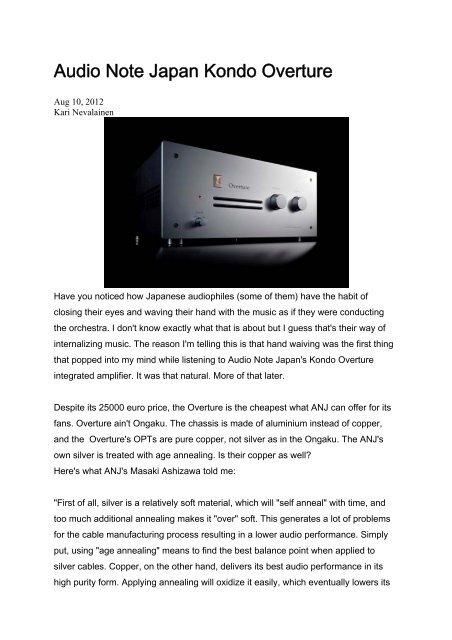
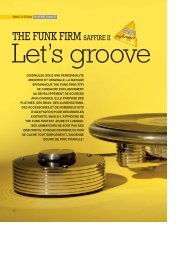
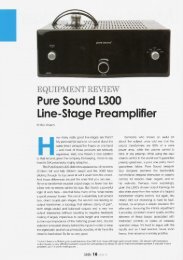


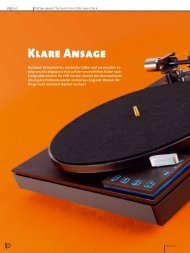
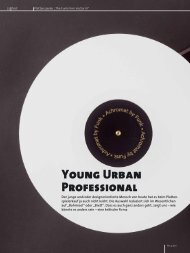
![Test KONDO M7 Vorverstärker bei STEREO 8/2006 [pdf 1,6MB]](https://img.yumpu.com/23165658/1/189x260/test-kondo-m7-vorverstarker-bei-stereo-8-2006-pdf-16mb.jpg?quality=85)
